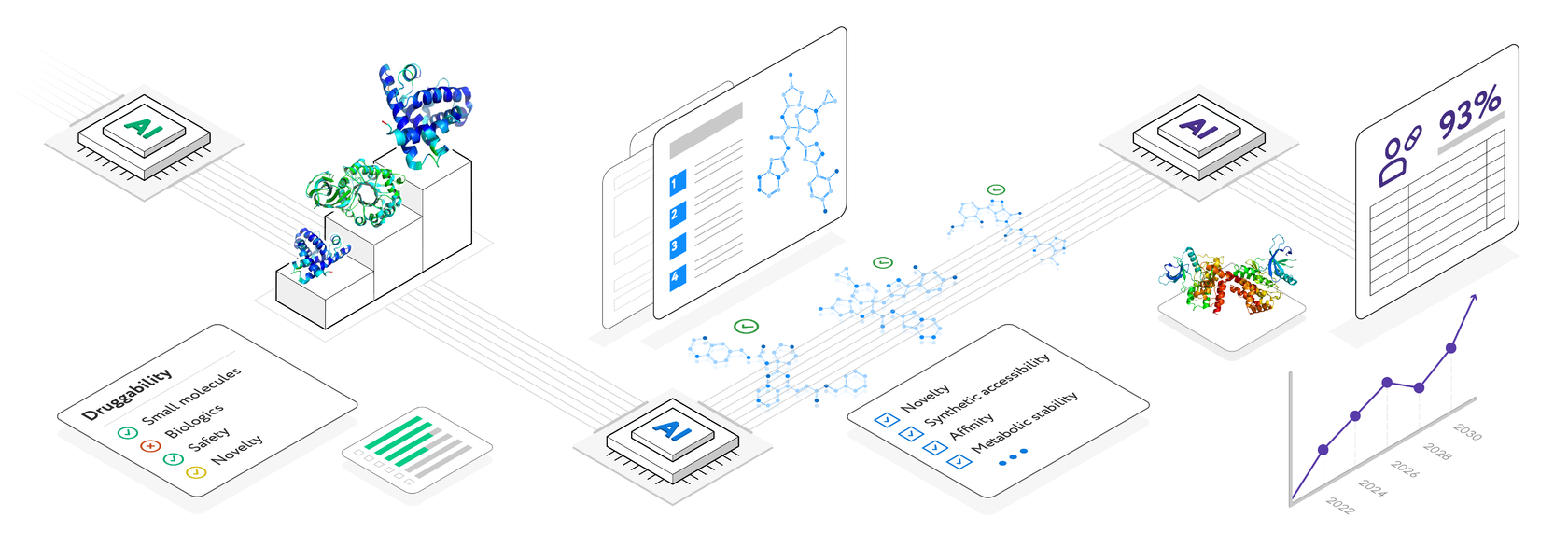Artificial Intelligence
for Drug Discovery and Personalized Research for Amyotrophic Lateral Sclerosis
for Drug Discovery and Personalized Research for Amyotrophic Lateral Sclerosis

An end-to-end
artificial intelligence-driven
drug discovery company
artificial intelligence-driven
drug discovery company
We develop artificial intelligence platforms that utilize deep generative models, reinforcement learning, transformer, and other modern machine learning techniques for novel target discovery and generation of novel molecular structures with desired properties. We focus on developing breakthrough solutions for the discovery and development of innovative drugs for cancer, fibrosis, infectious diseases, autoimmune diseases, and
age-related diseases.
Since 2014, Insilico Medicine has established strategic collaborations with more than 30 pharmaceutical and biotechnology companies and academic research groups in the United States, Europe, China, Japan and other countries and regions, and launched multiple internal R&D pipelines for novel, difficult and previously undruggable targets.
age-related diseases.
Since 2014, Insilico Medicine has established strategic collaborations with more than 30 pharmaceutical and biotechnology companies and academic research groups in the United States, Europe, China, Japan and other countries and regions, and launched multiple internal R&D pipelines for novel, difficult and previously undruggable targets.
ALS is a rapidly progressive, age-associated, and rare disease without an effective treatment. ALS patients usually expire within 2-5 years after diagnosis. Current FDA-approved drugs for ALS do not reverse any neuro-degeneration from patients, and some treated patients even showed no clinical benefit outcome. The use of advanced bioinformatics techniques
and deep learning, which showed promising results in many research areas, address the urgent need to develop new therapeutics for ALS.
and deep learning, which showed promising results in many research areas, address the urgent need to develop new therapeutics for ALS.

In 2016, Insilico Medicine partnered with Above and Beyond (A&B), a patient-sponsored research organization that manages and funds research on ALS. Using the latest developments in AI, Insilico Medicine identified a range of novel targets for new drugs and drug repurposing candidates. Although we could not comprehensively conclude the efficacy of our proposed candidates due to patient confidentiality, we devoted time and effort as well as gained valuable experience in researching ALS. Insilico Medicine has been conducting researches on target discovery and drug repurposing with other interested parties using PandaOmicsTM. This website, ALS.ai presents some of these works.
Insilico Medicine aims to cooperate with disease foundations and research associations to collect meta-data from ALS patients on experimental drug testing. This is the most rational pathway to identify potential therapy for ALS. Since experimental disease models did not provide the ideal test platform for hypothesis validation, Insilico Medicine is interested in collaborating with organizations and researchers to validate new drug targets or repurposing existing FDA-approved drugs against ALS in clinical trials. Given that new therapeutic agent can reverse damage in one ALS patient, it is likely to work in other patients. Insilico Medicine has created tools that can generate synthetic biological and molecular data, perform novel target identification, and help predict clinical trial outcomes and fully integrated drug discovery platforms, PandaOmicsTM, Chemistry42TM, and InClinico.
Insilico Medicine aims to cooperate with disease foundations and research associations to collect meta-data from ALS patients on experimental drug testing. This is the most rational pathway to identify potential therapy for ALS. Since experimental disease models did not provide the ideal test platform for hypothesis validation, Insilico Medicine is interested in collaborating with organizations and researchers to validate new drug targets or repurposing existing FDA-approved drugs against ALS in clinical trials. Given that new therapeutic agent can reverse damage in one ALS patient, it is likely to work in other patients. Insilico Medicine has created tools that can generate synthetic biological and molecular data, perform novel target identification, and help predict clinical trial outcomes and fully integrated drug discovery platforms, PandaOmicsTM, Chemistry42TM, and InClinico.
INTRODUCING FULLY-INTEGRATED DRUG DISCOVERY SOFTWARE SUITE
PHARMA.AI

Enabling multi-omics target discovery and deep biology analysis engine to considerably reduce required time from several months to the span of just a few clicks
Find novel lead-like molecules in a week through this automated, machine learning de-novo drug design and scalable engineering platform
Predict clinical trials success rate, recognize the weak points in trial design, while adopting the best practices in the industry
Discover and Prioritize
Generate
Design and predict
Novel Targets
Novel Molecules
Clinical Trials
ALS Target Discovery and Drug Repurposing using PandaOmicsTM
How can AI help ALS patients?
- Public or personalized datasets are analyzed in PandaOmicsTM for target identification.
- Drugs associated with the identified novel and known targets are curated and released onto ALS.ai.
- Feedback on the safety and efficacy of proposed drugs are collected from ALS patients and KOLs for further target validation.
- Combining the use PandaOmicsTM and ALS.ai significantly reduces the time required for novel target discovery and drug repurposing for ALS treatment.

Personalized Science
for ALS Patients
for ALS Patients
ALS is a disease that does not have any well-validated in vitro and in vivo models due to a high level of missing heritability. The majority of these models are developed based on a limited number of genes that are signatures of familial ALS, which accounts for less than 10% of the total ALS cases. Insilico Medicine aims to develop personalized therapies for ALS patients directly by utilizing our AI drug discovery platform. After identifying novel targets in ALS and the available drugs for repurposing, we comprehensively review these targets and collaborate with the hospitals and experts of ALS to discuss the possibilities to bring these therapeutics into clinical use.
In 2013, Zhavoronkov and Cantor proposed a model for personalized science, with a team of physicians and academic experts in a research center collaborating with a patient to generate a patient-specific research project for disease treatment (Rejuvenation Res, 16(5):414-8). This paradigm aims to determine the best course of action in just one patient as a N-of-1 study, and eventually identify alternative options for disease treatment.
In 2013, Zhavoronkov and Cantor proposed a model for personalized science, with a team of physicians and academic experts in a research center collaborating with a patient to generate a patient-specific research project for disease treatment (Rejuvenation Res, 16(5):414-8). This paradigm aims to determine the best course of action in just one patient as a N-of-1 study, and eventually identify alternative options for disease treatment.

In 2020, Insilico Medicine announced the release of PandaOmicsTM, an AI-powered target identification platform, as a component in the Pharma.AI platform designed to empower drug discovery and development pipelines.

Scientists and physicians could utilize the platform to conduct omics data analysis and interpretation conveniently. Furthermore, PandaOmicsTM acquires a deep biology analysis engine that helps reveal disease signatures and actionable targets in a disease-specific manner.
It offers several unique advantages in terms of user experience, complexity of the database, algorithms, and the validation approach. In addition to giving detailed instructions to guide users through each step of discovery, the platform dynamically yields a ranking of targets in TargetID based on the selection of different datasets, both custom uploaded and pre-processed in PandaOmicsTM. With just a few clicks, the platform is able to propose druggable targets using multiple advanced AI and bioinformatics models. Additionally, a multi-layer validation procedure is included
to estimate each model's performance in respect of the type of experimental data, protein family, disease area, ability to suggest novel targets, and so on. Therefore, PandaOmicsTM is a unique and user-friendly interface to explore therapeutic target based on multi-omics data analysis that requires no prior knowledge of computational biology.
To accelerate the discovery of repurposing candidates, PandaOmicsTM deployed the CompoundID feature to search for compounds related to disease treatment, as well as the Drugs and Clinical Trials page for each disease and gene. Integration of TargetID and CompoundID in PandaOmicsTM opens up a new chapter in medical industry.
It offers several unique advantages in terms of user experience, complexity of the database, algorithms, and the validation approach. In addition to giving detailed instructions to guide users through each step of discovery, the platform dynamically yields a ranking of targets in TargetID based on the selection of different datasets, both custom uploaded and pre-processed in PandaOmicsTM. With just a few clicks, the platform is able to propose druggable targets using multiple advanced AI and bioinformatics models. Additionally, a multi-layer validation procedure is included
to estimate each model's performance in respect of the type of experimental data, protein family, disease area, ability to suggest novel targets, and so on. Therefore, PandaOmicsTM is a unique and user-friendly interface to explore therapeutic target based on multi-omics data analysis that requires no prior knowledge of computational biology.
To accelerate the discovery of repurposing candidates, PandaOmicsTM deployed the CompoundID feature to search for compounds related to disease treatment, as well as the Drugs and Clinical Trials page for each disease and gene. Integration of TargetID and CompoundID in PandaOmicsTM opens up a new chapter in medical industry.

To initiate a research project using PandaOmicsTM, users could start by searching for the disease-of-interest on the Main Page.
For every disease, the platform offers details in research dynamics, associated datasets, genes, key opinion leaders, as well as drugs and clinical trials. Despite performing differential gene expression and pathway analysis with given datasets, PandaOmicsTM equips a unique feature, named TargetID, to facilitate users in the discovery of potential molecular targets for a selected disease with a customized choice of datasets. By switching on or off Omics Score, Text scores, and Druggability filters, disease targets could be prioritized based on the user's interest, accelerating the process of target hypothesis generation.
For every disease, the platform offers details in research dynamics, associated datasets, genes, key opinion leaders, as well as drugs and clinical trials. Despite performing differential gene expression and pathway analysis with given datasets, PandaOmicsTM equips a unique feature, named TargetID, to facilitate users in the discovery of potential molecular targets for a selected disease with a customized choice of datasets. By switching on or off Omics Score, Text scores, and Druggability filters, disease targets could be prioritized based on the user's interest, accelerating the process of target hypothesis generation.
Disease Summary
An overview of the disease is available on PandaOmicsTM providing information of grants, funding, drugs and clinical trials related to ALS. PandaOmicsTM collects data from literature databases to predict the disease's attention trend around the world in the recent years.
Drugs and Clinical Trials
Development progress of ALS drugs is shown on PandaOmicsTM in the form of an interactive bar chart displaying the number of drugs in clinical trials ranging from phase 1 to 4. Detailed information of specific drug or clinical trial could be identified by searching trial ID, development stage, compound type, associated disease, target, or sponsorship in
the given tables easily. Additionally, drugs are well-classified based on their generic names in collapsed mode, saving users time painstakingly tracking compounds under different brand names.
This feature helps users to learn the advancement
in disease treatment, explore potential therapies
for patients, and possibly, discover less competitive targets, compounds and disorders for further investigation.
the given tables easily. Additionally, drugs are well-classified based on their generic names in collapsed mode, saving users time painstakingly tracking compounds under different brand names.
This feature helps users to learn the advancement
in disease treatment, explore potential therapies
for patients, and possibly, discover less competitive targets, compounds and disorders for further investigation.
Dataset Selection
Users do not need to spend time trying to convert data into an interpretable format or wait for a bioinformatician to do that — instead, all the data are already processed and uploaded in a uniform way, so users can focus on science and data interpretation. Original and processed attributes are available for users to build up sample groups for comparisons within a few clicks.
Target Identification
PandaOmicsTM allows target exploration even if you are new
to data analysis. Starting from a disease of interest, the system applies an AI hypothesis generation system to rank all related genes according to a wide range of omics and text data types.
The omics part includes the most popular public repositories available through the search. For the text database, the platform applies in-house text processing as well as entity recognition techniques. The database is curated and tailored to solve the target discovery problem specifically. There are a total of 21 attributes and flexible Druggability filters to refine the list to
to data analysis. Starting from a disease of interest, the system applies an AI hypothesis generation system to rank all related genes according to a wide range of omics and text data types.
The omics part includes the most popular public repositories available through the search. For the text database, the platform applies in-house text processing as well as entity recognition techniques. The database is curated and tailored to solve the target discovery problem specifically. There are a total of 21 attributes and flexible Druggability filters to refine the list to
satisfy user's research goals.
The balance between novelty and confidence is a key for target discovery. Once you have a shortlist of putative targets, users can adjust the Novelty filters to Low, Medium, or High based on the volume of related publications proposed by the proprietary AI engine. Loss of novelty will be a trade-off for the abundance of evidence connecting a target to a disease. In contrast, increasing the degree of novelty will sacrifice the confidence level of a target. If you are interested in exploring the highly novel targets, feel free to contact us for collaboration.
The balance between novelty and confidence is a key for target discovery. Once you have a shortlist of putative targets, users can adjust the Novelty filters to Low, Medium, or High based on the volume of related publications proposed by the proprietary AI engine. Loss of novelty will be a trade-off for the abundance of evidence connecting a target to a disease. In contrast, increasing the degree of novelty will sacrifice the confidence level of a target. If you are interested in exploring the highly novel targets, feel free to contact us for collaboration.

TargetID results for targets
with low novelty
with low novelty
Potential therapeutic targets for ALS with abundant evidence were generated by setting the Novelty filter at a low level. Simultaneously, Druggable classes, Omics scores, Text-based scores, Financial scores, and KOL scores were applied.
TargetID results for targets
with medium novelty
with medium novelty
ALS targets could also be identified without prior knowledge by restricting the Novelty filter at a medium level, selecting only the Omics scores, and disabling the Text-based, Financial, and KOL scores.

